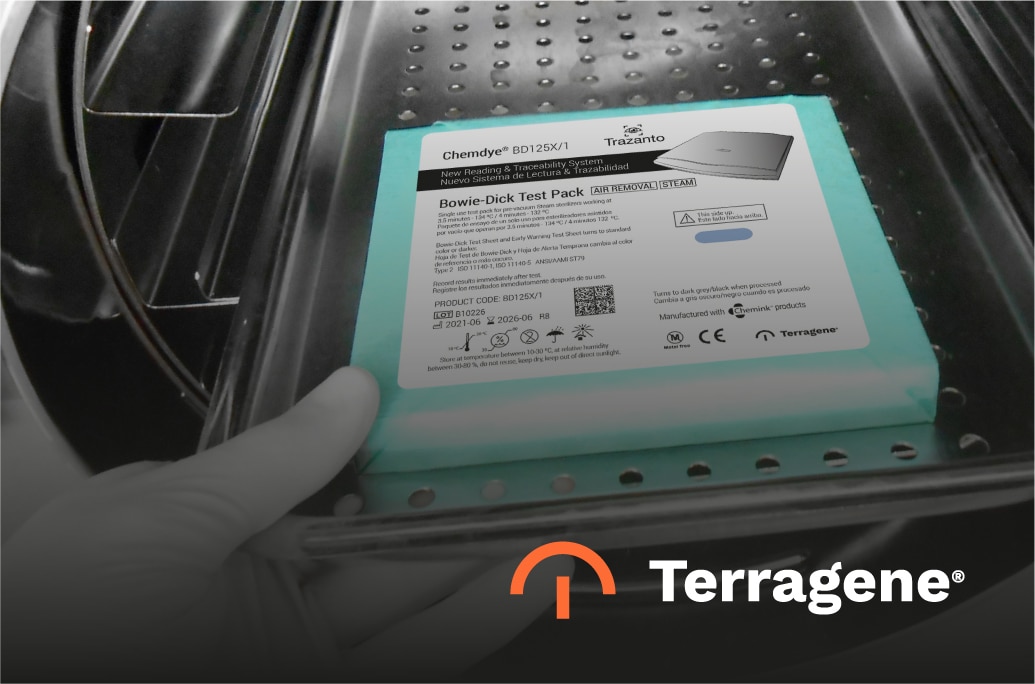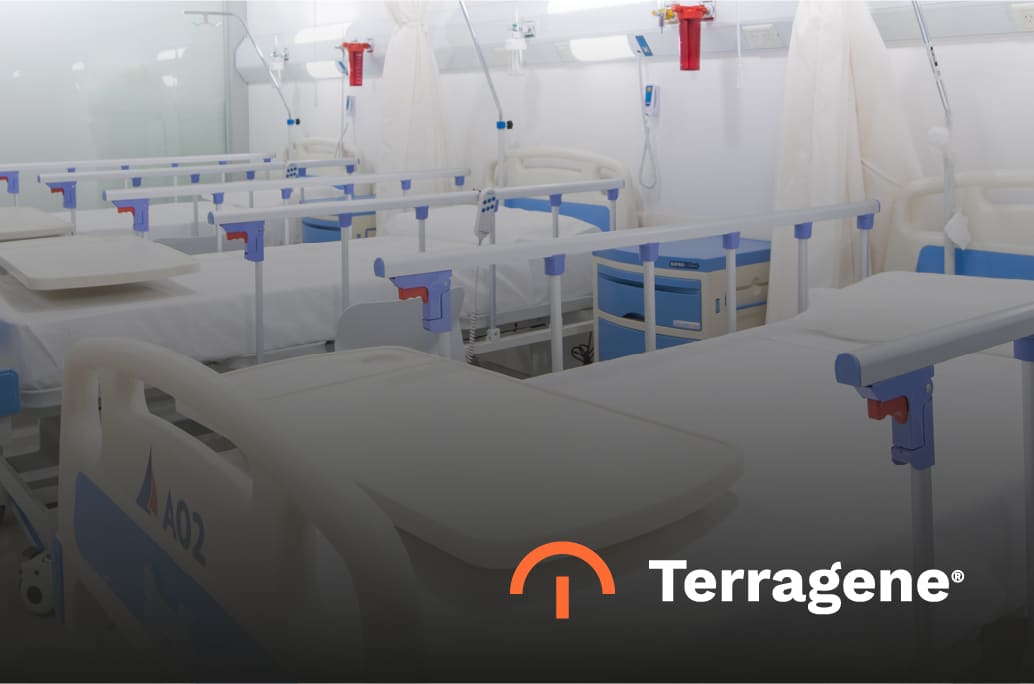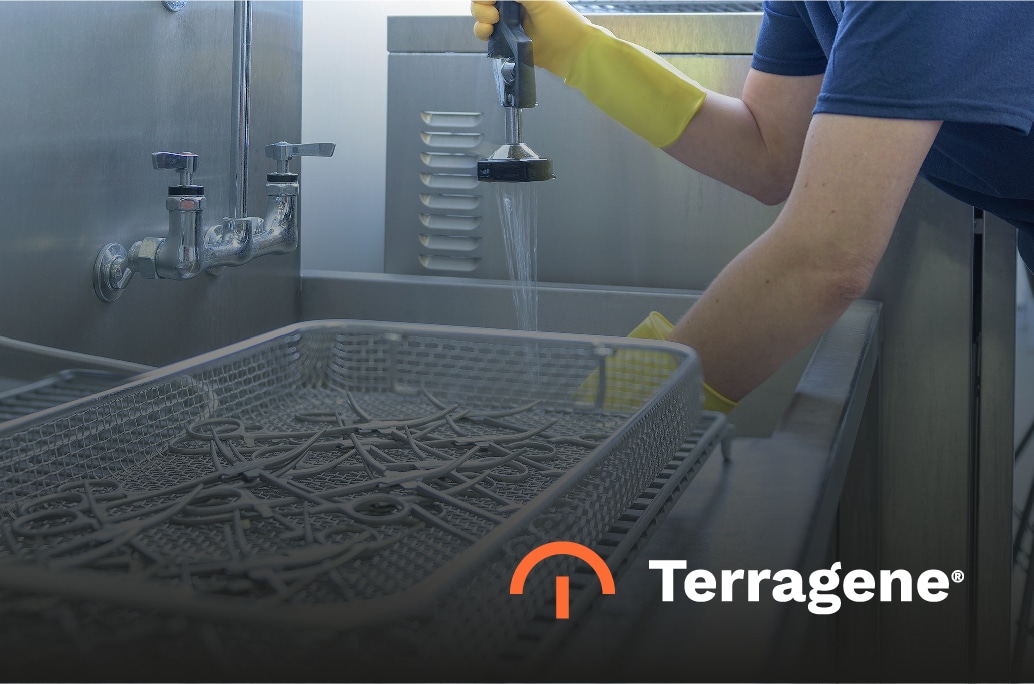TerraBlog

Perfect wash control system: a complete and automated cleaning monitoring system
When reprocessing instruments, all the cleaning-related steps are critical to achieve a successful sterilization cycle. If you are not sure they are clean, it doesn't matter what you do next!
* Are you monitoring every load and every rack?
* Are you performing absolute protein quantification?
* Have you ever thought about an automated and complete traceability system for the cleaning procedures?
There are too many parameters involved in a washing cycle; it is essential to monitor them to guarantee an optimal performance of this process.
Ensure success with the most complete and automated cleaning monitoring system for SPD/CSSD. Discover our perfect wash control system. Go to: LINK PDF

Bowie-Dick Test Pack: Good practices
Chemdye® Bowie & Dick Test Pack detects air leaks, inadequate air removal and steam penetration level in vacuum-assisted steam sterilizers. The Chemdye® Bowie & Dick Test Pack consists of a chemical indicator sheet between porous material sheets and wrapped forming a package, with a steam indicator label. The central sheet, with a regular pattern, corresponds to a Bowie & Dick classic indicator.
Terragene® manufacture different presentations of Bowie & Dick Test Packs according to the market demands and regulations.

Room Disinfection: which technology should I choose?
By Dr. Nicolas Hedin
In 1991 a study by Weinstein revealed that healthcare-associated infections - or HAI were 40 to 60% caused by patient’s endogenous flora, between 20 to 40% through the hands of hospital personnel and approximately a 20% of the cases were due to environmental, food or air contamination (1). There is mounting evidence pointing towards the importance of ambient cleaning/disinfection to prevent and control HAI in hospitals (Dancer, 2009). The common HAI-causing pathogens have the innate ability to survive on different surfaces inside the hospital for long periods of time (Dancer 1999) (Figure 1). Among these organisms, the most common are: Clostridium difficile, meticillin-resistant Staphylococcus aureus (MRSA), vancomycin-resistant enterococci (VRE), Acinetobacter spp. and norovirus (2).
Scientific evidence shows that contaminated surfaces contribute positively to the endemic transmission of most of these pathogens. Admission of a healthy patient to a room previously occupied by a VRE, MRSA or Clostridium difficile infected person, increases the chances of HAI infectionby at least a factor of two (3). There is also a study showing that improving room disinfection reduces the increased risk of HAI infection (4). Zimlichman et al. estimated in the year 2013 that 9.8 billion dollars per year are spent due to HAI infections. It is thus clear that proper environmental disinfection is a key point when discussing healthcare (5).
In the year 2011 Manian and collaborators (6) demonstrated that rooms contaminated with multidrug-resistant Acinetobacter baumannii complex and MRSA were difficult to clean and even after four rounds of cleaning/disinfection with bleach, the pathogens remained in the room. The authors concluded that the suboptimal conditions of the cleaning/disinfection process per se are the causes of these results rather than the ineffectiveness of the disinfectant. Several other studies point toward the same direction (7 - 10) and highlight the importance of the human factor. Finding the proper protocol seems mandatory, and educating the personal is also a key point, as this might help them understand the importance of their activity. It is also a fact that modifying human behavior is sometimes a difficult task: while the education process is active and on-going, the results are positive but after some months they return to the starting point (11 - 12). In this sense, the development of the “no-touch automated room disinfection” (NTD) technology helps achieving proper cleaning and disinfection standards. But …how many flavors do we have?
In the last years several NTD systems have been developed and the most tested and useful ones rely on hydrogen peroxide H2O2 or ultra-violet radiation (UV). Both technologies are nowadays in the spotlight, as they have been proposed as accepted methods for N95 masks decontamination, according to CDC (https://www.cdc.gov/) given the actual context of COVID-19 where there is a shortage of N95 masks. It seems clear that H2O2 microbicidal activity is due to the oxidation of pathogen’s molecules and also through the formation of free radicals and other reactive species, although further studies are required (13). UV mechanisms are well studied, and the microbicidal effect is given by the un-stabilization of certain purines, pyrimidines and flavin bonds, thus affecting DNA and RNA leading to their dimerization (14). NTD technology has grown in the last years and several different options were developed, in the next paragraphs I will discuss the most popular approaches used nowadays: aHP, H2O2 vapour, UVC and mixed O3/H2O2 technologies.
aHP stands for aerosolized hydrogen peroxide. This technology delivers H2O2 generated by pressure from a solution with a relatively low concentration of the active principle (5-6% H2O2). Peroxide is delivered together with approximately 50 ppm of silver cations which are thought to help stabilizing hydrogen peroxide and also improving bactericidal efficacy by binding with disulfide (S-S) and sulfhydryl (-SH) groups found in proteins from the bacterial cell-wall (15 - 17). The Ag+2 ions keep the O-2 ions. Different particle sizes can be generated according to the setup of the equipment manufacturer (from 0.5 to 10 µm) (18, 19) generating the called ‘dry-mist hydrogen peroxide’, which is naturally decomposed to oxygen and water after exposure. There are several studies stating that 4-log reduction of C. difficile is possible, but no satisfactory results (with standard equipment) are obtained when 6-log spore biological indicators are used (20). Recently, an aHP based system claimed a 6-log reduction of Geobacillus stearothermophilus by means of 12% plasma-activated H2O2 (21). In general terms aHP is an easy-to-use technology and it is the cheapest one, but depending on the room size, multiple aHP units may be required. Sealing doors and air vents is mandatory and the process extends from 2 to 4 hours depending on the amount of cycles required.
Vaporized H2O2 (vH2O2) is the second and one of the most proven options. This technology uses heat (130°C) to vaporize a 30 – 35% hydrogen peroxide solution. vH2O2 achieves higher amounts of active H2O2 (150 – 750 ppm) compared to aHP (less than 160 ppm) and generates homogeneous vapors throughout the room to be decontaminated. Two different approaches can be mentioned: HPV for hydrogen peroxide vapor and VHP for vaporized hydrogen peroxide. HPV generates a saturated peroxide hydrogen atmosphere that condensates on surfaces (22, 23), while VHP does not generate condensation. Both systems were repeatedly proven to be effective against hard to kill bacteria (C. difficile spores, MRSA, VRE, A. baumannii and norovirus) and Geobacillus stearothermophilus BI spores. This is the chosen option when there are pathogens’ outbreaks (i.e. C. difficile and A. baumannii) (24). HPV technology has the disadvantage of using two separate units, the generator unit and the aeration unit, which makes it more complex. In general, vaporized technology needs a minimum of training of the personnel who will be in charge of the following tasks: seal the room to be disinfected in order to avoid H2O2 leakage; control the equipment and measure remaining peroxide on the room prior to re-entrance (by means of a hand-held monitor). Cycles vary in time, as they depend on the room-size, but they can last between 2 to 8 hours.
UV radiation can be divided into three groups according to its wavelength: UVA from 315 – 400 nm, UVB 280 – 315 nm and UVC from 200 – 280 nm. UVC is absorbed by nucleic acid and thus is the most lethal option for microorganisms (25). UVC radiation needs to be in direct contact with the surface to be disinfected, and thus the system is most often capable to automatically “move” around the room to be disinfected. In this context, UVC has been proposed as a reliable method to decontaminate N95 filtering face-piece respirators (FFRs) (26). 3 - 5 log reduction of H1N1 influenza virus was achieved using UVC technology (26, 27). Apart from regular UVC continuous light systems, there is also another technology based on Xenon lamps, which uses light pulses and is called PX-UV. There is no consensus about which technology is better as there are relatively few reports about pulsed technology (28, 29). A main advantage of UV based technology compared to H2O2is the short time required for disinfection (10 - 45 minutes average) (30), and no sealing of the room is needed, saving even more time. On the other hand, UV disinfection process is more difficult to assess than peroxide based processes, as much of the disinfection effectiveness will depend on the distance to the light-emitting source and the nature of the incidence light (direct or indirect).
No-touch automated room disinfection technology is a solution for any place where HAI causing organisms might be present: Sterile Processing Departments (SPD or CSSD), healthcare facilities and industry also, but care should be taken to assess the correct functioning of these technologies as they are different one from the other (Table 1). Traditional microbiological approaches are not practical for routine analysis as they require sample cultivation and identification which is a time-consuming process and is expensive. There are alternatives to replace traditional test. On the one hand, commercially available biological indicators can be used, and as an example there are on the market fluorescence-based biological indicators which ensure the correct inactivation of a 1x106 spore population of Geobacillus stearothermophilus by means of hydrogen peroxide, giving a quick 1 hour readout so the room can be liberated almost instantly. There are also tridimensional chemical indicators that can be used to assure the correct exposition of the room to the peroxide hydrogen, both for aerosol and for vaporized hydrogen peroxide. As UV disinfection process is more difficult to assess, these processes should be carefully evaluated by employing indicators in every hard-to-reach place. There are chemical indicators and chemical dosimeters to ensure that a surface receives the correct UV-dose and a recently released 3D UV chemical indicator allows to assess the correct room UV-disinfection.

SPD/CSSD Hygiene Monitoring Systems: Protein & ATP Tests.
ATP testing was born to serve a specific purpose in the food industry market: to
monitor microbiological possible contaminations after washing/disinfection of
the surfaces and machines. After this, and as consequence of healthcare
acquired infections outbreaks a few decades ago, hospitals started to perceive
that they need to incorporate a similar control inside the SPD/CSSD. Since there
was no better technology or testing method available rather than ATP at that
time, both hospital’s urge and manufacturer’s smartness, led the market to
incorporate this testing method inside hospitals.
However ATP systems does not seem to be the best choice for this specific
purpose. And below a list of reasons why:
• The main objective of a washing/cleaning process in hospitals is to eliminate
blood and tissue remainings, thus guaranteeing that subsequent disinfection
and sterilization processes will be successful. Nowadays, the main challenge that
washer and detergent manufacturers face, is the complete removal of proteins
from reprocessed instruments. Thus, if we are talking about a test for cleaning
effectiveness, protein should be the chosen one, because, in biological samples,
there is nothing more adherent than proteins. In this sense, blood and tissue
residues consist of different cell types and free proteins. The most diffcult to
remove are the proteins that coagulate and adhere to the instruments, making
the washing process very di_cult to accomplish successfully. So, why bothering
to measure ATP levels if instruments will subsequently be exposed to a sterilization process to remove any living cell remaining? This points out ATP detection is mainly recommended for disinfection control in places like the food industry.
• ATP does not represent a contamination itself, so microbial or organic
contamination will always be an indirect measure (when measured by ATP). On
the other hand, protein residues do represent a direct measure of
organic/microbial contamination. Not only this, but more importantly, proteins
are the most di_cult to remove residues during a cleaning process. For this
reason, if we are talking about cleaning effectiveness, protein testing is
undoubtedly the best marker.
• ATP is a very easy to hydrolyse molecule, so it does not represent a challenge
to the washing procedure. In this sense, hospital washing/cleaning parameters
do guarantee that any ATP molecule will be destroyed during the process
(temperature, detergents or disinfectants, etc). Not only this, but if there is any
chance that ATP molecules remain after the washing cycle, free ATP will
inevitably hydrolyse within a few minutes. Consequently, it is very unlikely that an
ATP test will give a significant result after a hospital washing cycle.
• It has been proved that some ATP tests fail to lyse some bacterial cells, thus the
release of ATP for later detection may be compromised. (if we consider ATP as a
microbial testing). Again, for instruments that will undergo a sterilization process
after cleaning/disinfection, it would not be the best recommendation to test for
bacterial contamination.
• It has also been shown that some detergents and disinfectants used in
hospitals interfere with the bioluminescence reaction.
• ATP is not present in viruses and, more importantly nowadays, in Prions, protein
infectious agents composed entirely of a protein material that causes transmissible spongiform encephalopathies, such as variant Creutzfeldt-Jakob disease. Remarkably, proteins are one of the main components of viruses, while
prions actually are infectious proteins themselves.
The relevance of this issue is such that institutions such as the UK Department of
Health have set limits on micrograms (_g) of protein to consider an instrument
as "clean” in The Health Technical Memorandum 01-01 (HTM 01-01). Therefore it
is not enough with the simple detection of proteins, but also its quantification by
electronic systems of high sensitivity and temporary analysis of the evaluated
samples is important.
Chemdye® PRO1 MICRO represents an easy option to monitor the cleaning of
reusable medical devices in the context of medical, dental practices and industry
from the detection and quantification of surface proteins, allergens and reducing
agents. The system consists of a swab of special characteristics and two reactive
solutions contained in the same device. PRO1 MICRO offers a quantitative
colorimetric result that can be measured with high sensitivity using any of the
Bionova® Auto-readers: IC10/20FR, IC10/20FRLCD and MiniPro.
For the detection of microorganisms by means of ATP; the available system is
Chemdye® ATP-S1. This product is similar to PRO1 MICRO in its structure; but the
biochemical reactions are completely di_erent. In fact this one is based on an
enzymatic reaction. ATP, the energy source of microorganisms, triggers a light
reaction that can be measured in a Luminometer. It is worth to note that this
system does not recognize proteins of any nature.
In conclusion, proteins do fulfil all the requirements to be the marker molecule
for cleaning effectiveness monitoring. In fact, today our Chemdye® PRO1 MICRO
system has become the most reliable cleaning monitoring system in the market.
Additionally now with Chemdye® ATP-S1 the users can also access to highly
sensitive ATP detection system to fulfill their entire requirements related to
microbial contamination assessment.

